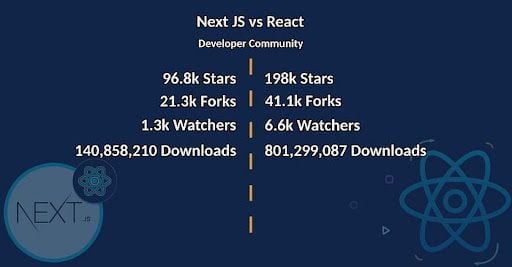React is a JavaScript library for building user interfaces, primarily used to create dynamic and interactive web applications through reusable components. Next.js is a React-based framework that adds powerful features like server-side rendering, static site generation, and routing out of the box, making it easier to build fast, scalable and SEO-friendly web applications.
Is React a Framework?
No, React is a JavaScript library used for building dynamic and interactive user interfaces. While React itself is not a framework, a popular tool called Create React App simplifies setting up a new React project by handling the initial configuration.
However, if you’ve decided to use React for your web app, you may have heard about Next.js and how it’s better at some things than React. Next.js’ rising popularity shows that developers trust it even though it is a relatively new competitor compared to other frameworks and React.

In this article, you will:
- Gain a basic understanding of React and Next.
- Find out why React is not a framework and Next is a framework.
- Learn about both tools’ features and how they perform to help you decide which tool to use for your next web application.
What Is React?
React is a JavaScript library that was created by Facebook in 2011 and then open-sourced in 2013. React made headlines as an efficient, flexible and declarative JavaScript library for building interactive websites. It’s really good at developing web apps that require constant data changes on their user interfaces. Its most successful apps are Instagram and Facebook, which are notable for being responsive and fast.
If you’ve ever developed a website using only primitive technologies, you know that after clicking on anything, the website refreshes. It’s hard to find anything like that on the web these days.
The fundamental building blocks of React are called components. These components manage and display data. When a component’s data changes, React efficiently updates and re-renders the UI to reflect those changes. This process is known as rendering, and is considered efficient in React.
Why React Is Not a Framework
You may have read debates on whether React is a framework or a library. To cut to the chase, it’s a library. Developers generally use the terms “library” and “framework” interchangeably, but they’re not the same. The main criteria for frameworks are:
- Frameworks provide ready-to-use tools, standards and templates for fast application development, while libraries don’t.
- Frameworks control the calling of libraries for our code.
- Frameworks give rules and guidelines on writing your code and structuring files and folders.
- Frameworks are consistent with APIs, compilers, toolsets and libraries within.
- When you use a framework, the control is inverted. The framework controls the flow and calls your code. In contrast, libraries let you control the flow of the application.
React does not match these criteria and thus, is not a framework.
What Is Create React App (CRA)?
To compete with frameworks, React has a dedicated framework called Create React App (CRA). It includes file structuring and other tools so that React could be used as a framework. It’s the best way to start building a new single-page application in React.
CRA creates a development environment to build a React-based web app and optimizes your app for production right out of the box.
A few things good to know are that CRA doesn’t handle back end logic or databases, and it uses Babel and webpack. I would recommend learning about them if you want to dive deep into the subject.
What Is Next.js?
Next.js is a lightweight open-source framework created by Vercel and released in 2016, . It was built on top of React to improve the experience and add additional features. It’s used to build optimized and fast web apps thanks to its static site and server-side rendering stages.
Next.js is popular among frameworks thanks to the following features:
- Typescript: This language is gaining popularity and I would recommend learning it if you haven’t already. It’s built on JavaScript. Next.js supports Typescript.
- Redux: Next.js seamlessly supports Redux, which React developers really like.
- Optimal speed: Next.js has two pre-render stages. The first one is server-side rendering (SSR), which allows us to fetch data and render it at the time of request. The other is static generation, which uses data available before request and helps us to cache data to get better SEO. That way, web crawlers can interact with a fully pre-rendered HTML page. Vercel claims that Next.js is one of the fastest frameworks, and they are right.
- Configurability: Next.js is easily configurable, as any good framework should be. Auto-generated styling solutions simplify development and provide template starters to kickstart your project.
- Routing: Creating page routes is as easy as creating folders.
React vs. Next.js
Now that we know the basics of Next.js and React, we can compare them to determine when to use each one. Choosing the main tool for your application is very important.
Advantages of React
- React is easier to learn than Next.js. It has extensive documentation to get started quickly.
- React has thousands of packages and tools, making development more efficient.
- React uses JavaScript, a powerful and flexible language that enables developers to create dynamic applications.
- A strong community with 197,000 starts on Github (as of this time of writing), which makes searching for help a lot easier.
- React’s reusable component system allows developers to reuse code and create more readable codebases.
- Create React App tool lets developers kick off their projects fast and without a hassle.
Disadvantages of React
- SEO can be challenging for client-side rendered React apps because crawlers may see a blank page; Next.js is preferred for SEO due to its built-in server-side rendering (SSR).
- React has slower initial performance and load times compared to Next.js, due to Next.js’ server-side rendering (SSR) and static generation (SSG) features.
- Developers need tools like CRA to create a project faster. Otherwise, the configuration may be difficult and take too much time.
-
React gets consistent updates, thus developers need to watch every update for React as new features can be added at any time. Documentation may become outdated quickly and is not necessarily updated at the same time as updates.
Advantages of Next.js
- Developers don’t need extra configuration to create an SSR app, while React needs CRA.
- Out-of-the-box experience. No need to worry about extra tools or bundlers as everything is done for you at project creation.
- Next.js was built with SEO in mind. SSR makes applications build on Next.js faster for so-called crawlers that visit your website and gather data for search engines.
- Performance is a big advantage of Next.js. Thanks to SSR and Static generation, applications built with it are fast.
- Next.js optimizes images, which helps with performance.
- Next.js allows you to import CSS files from a JavaScript file. This is possible because Next.js extends the concept of import beyond JavaScript.
- Next.js has its own folder structure which makes the process more intuitive and simple.
Disadvantages of Next.js
- It can take more time to build larger sites with Next.js.
- Routing isn’t that flexible, as Next.js has its own integrated routing system.
- Without React fundamentals, it will be harder to create new projects.
Why Understanding React Is Important
Whether you are using Next.js or React, both are based on React, and you will be coding in React. Understanding React UI libraries and core aspects is a must. React doesn’t need Next.js, but Next.js needs React.
The main difference between CRA and Next.js is that CRA will run on the client’s browser, while Next.js will run on the server.
Frequently Asked Questions
Is React a framework or a library?
React is a JavaScript library used for building dynamic, interactive user interfaces for websites. It does not provide the same ready-to-use tools, rules and control flow as a framework.
What is the main difference between React and Next.js?
The main difference between React and Next.js is that React is a JavaScript library focused on the user interface, while Next.js is a framework built on top of React. Next.js offers features like server-side rendering and a file-based routing system, which are not included in a standard React setup.
Why would a developer choose to use Next.js over React?
A developer might choose Next.js for its built-in features that improve performance and SEO. These include server-side rendering, static generation, image optimization and simplified routing.





